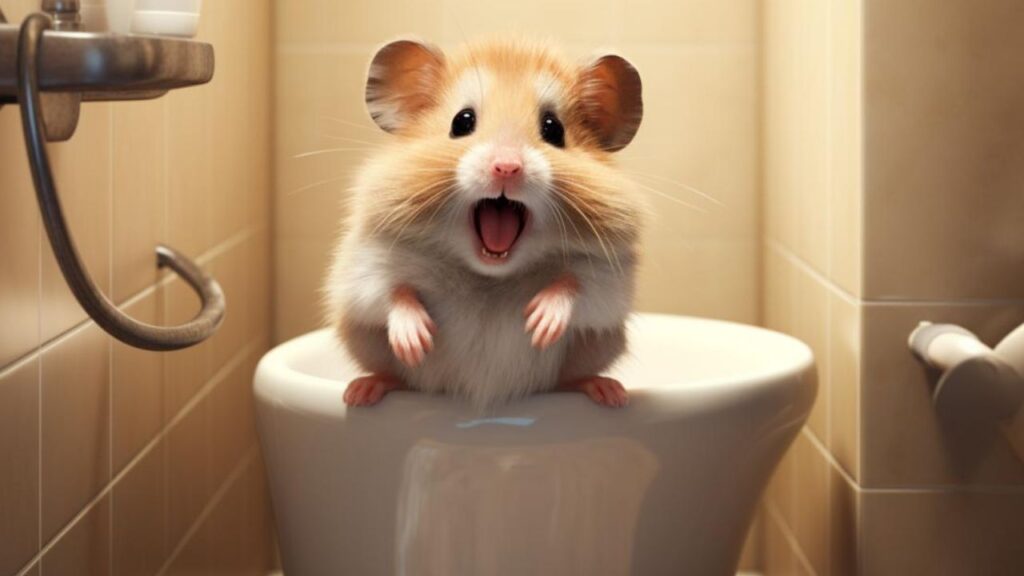Welcome, fellow hamster enthusiasts, to a whisker-twitching journey into the world of our furry little friends! I’m SmartyPaws, your guide to all things hamster, and today, we’re delving into a topic that’s as heartwarming as it is crucial: recognizing the signs of a happy and healthy hamster. You see, these pint-sized pets may not speak our language, but they communicate volumes through their behavior, appearance, and habits.
Understanding the signs of a happy and healthy hamster is more than just a delightful dive into their world; it’s an essential aspect of responsible pet ownership. These adorable creatures depend on us for their well-being, and being attuned to their happiness and health is our duty. It’s like being a detective, but instead of solving mysteries, we’re ensuring our furry pals lead the best lives possible.
In this article, we’re not just going to scratch the surface; we’re burrowing deep! We’ll explore the top 10 signs that your hamster is living its best life. From the pep in their step during playtime to the sheen of their coat, each sign is a piece of the puzzle in understanding your hamster’s well-being. We’ll cover everything from their playful antics and eating habits to their sleeping patterns and social behaviors. By the end of this read, you’ll be a veritable hamster happiness expert, equipped with the knowledge to keep your fluffy friend not just surviving, but thriving. So, grab your detective hat (or wheel, if you prefer) and let’s get rolling on this exciting exploration!
Active and Curious Behavior

Ah, the bustling energy of a happy hamster – it’s like watching a fluffy ball of joy on a never-ending quest for fun! When a hamster is in good spirits and health, its behavior mirrors that of an intrepid explorer, full of curiosity and zest for life. This section will whisk you through the lively world of a content hamster, highlighting how their exploration, playfulness, and interactions with us humans paint a picture of their happiness and well-being.
Exploration: How a Happy Hamster Behaves in Its Environment
In the wild, hamsters are natural explorers, and this trait doesn’t vanish in captivity. A happy hamster is often a busy hamster, displaying a keen interest in its surroundings. You might notice your furry friend eagerly sniffing around, climbing, or digging in its bedding. This explorative behavior is a hamster’s way of engaging with its world, and it’s crucial for mental stimulation. Providing a habitat with tunnels, hideouts, and safe objects to climb ensures your hamster can indulge in its natural exploratory instincts, keeping its mind sharp and spirits high.
Playfulness: Examples of Playful Behavior
Playtime is the highlight of a hamster’s day, and a jovial hamster will show a variety of playful behaviors. Watch for antics like sprinting on their exercise wheel – a universal hamster favorite – or perhaps performing acrobatics with toys in their cage. Some might even create a game out of rearranging their bedding or navigating mazes you set up. These playful actions are not just fun to watch; they are pivotal for their physical health and emotional well-being.
Interaction: How Hamsters Interact with Their Owners When Happy
The bond between a hamster and its human can be a source of immense joy for both. A contented hamster may show a willingness to interact with you, such as approaching the cage’s door when you’re near or accepting treats gently from your hand. Some might even enjoy gentle pets or scurrying onto your palm for a quick cuddle. Remember, each hamster has a unique personality, so their ways of showing affection can vary. The key is patience and understanding, allowing your furry friend to approach you on their terms, which is a sure sign of trust and happiness.
Healthy Eating Habits

When it comes to hamsters, dining isn’t just about filling their tiny tummies; it’s an art form, a delicate dance of nutrition and taste. In this segment, let’s nibble our way through the dietary do’s and don’ts of hamster care, understanding how healthy eating habits are a cornerstone of their overall well-being. Just like us, these little furballs need a balanced diet to stay in tip-top shape, and recognizing these eating patterns is key to ensuring they lead a long and joyful life.
Consistent Eating: What Healthy Eating Looks Like in Hamsters
A hamster with healthy eating habits is like a well-oiled machine; it eats regularly and with gusto. You’ll notice your hamster munching on its food at consistent times, usually around dusk or dawn due to their crepuscular nature. Healthy eating involves a mix of store-bought hamster pellets, fresh fruits, and vegetables, with a keen interest in their meals. If your hamster is leaving food untouched or seems disinterested in eating, it might be a red flag. However, a hamster that eagerly awaits mealtime, with a steady eating schedule, is often a happy and healthy one.
Food Preferences: Discussing Varied Diet and Favorite Treats
Variety is the spice of life, and this holds true for our hamster friends too! A happy hamster enjoys a diet that’s not just nutritious but also diverse and exciting. Integrating a mix of grains, seeds, nuts, fruits, and vegetables caters to their nutritional needs and keeps mealtime interesting. It’s like a mini buffet in their habitat! And let’s not forget treats – occasional nibbles like a small piece of apple or a few sunflower seeds can be delightful rewards. However, moderation is key, as overindulging in treats can lead to health issues. Observing your hamster’s preferences and adjusting their diet accordingly ensures they not only eat healthily but also joyfully.
Signs of Good Nutrition: Physical Signs in a Hamster that Indicate a Healthy Diet
A well-nourished hamster is a showcase of health and vitality. You can spot signs of good nutrition through various physical indicators. A hamster on a healthy diet boasts a shiny, full coat and bright, clear eyes. Their energy levels are high, and they maintain a steady weight – not too chubby, not too thin. You’ll also notice that their droppings are firm and consistent in size and shape, an often overlooked but vital sign of good digestive health. Remember, a balanced diet is the foundation of these positive physical attributes, reflecting directly in their overall health and happiness.
Healthy Appearance

Stepping into the world of hamster glamour, it’s not just about looking good; it’s a reflection of robust health and happiness. A hamster’s appearance is like a window into its well-being, and knowing what to look for can help us ensure they are not just cute, but cheerful and healthy too. Let’s fluff up our knowledge and learn about the dazzling signs of a well-groomed, healthy hamster.
Coat and Skin: Describing a Healthy Coat and Skin
The coat of a healthy hamster is like a fluffy cloud on a sunny day – soft, full, and glossy. A good coat is a telltale sign of proper nutrition and care. It should be free of bald patches, mats, and parasites like mites or fleas. The skin underneath should be clear of any redness, sores, or flakiness. Regular grooming by your hamster, such as self-cleaning and fur fluffing, is a good indicator that they’re taking care of their fabulous coat. If you notice your hamster’s coat looking dull, patchy, or if they’re excessively scratching, it’s time to consult a vet. Remember, a healthy coat isn’t just about aesthetics; it’s a badge of health and pride!
Eyes and Ears: Signs of Health in a Hamster’s Eyes and Ears
Peering into the eyes of a healthy hamster, you should see the sparkle of curiosity and contentment. Their eyes should be bright, clear, and free of any discharge or cloudiness. Crusty or watery eyes can indicate health issues. Similarly, their ears should stand perky and be clean without any discharge, swelling, or excessive wax build-up. A hamster with healthy eyes and ears is not just alert and aware of its surroundings, but also in a state of overall good health. These sensory tools are vital for their interaction with the world, and keeping them in tip-top shape is paramount.
Weight and Body Condition: How to Tell if Your Hamster is at a Healthy Weight
Just like in humans, weight is a crucial health indicator in hamsters. A healthy hamster should feel well-rounded – not too skinny and not obese. You can assess this by gently feeling their body; you should be able to feel their ribs but not see them. Their body should be proportionate, with a visible waist and no bulging belly. Overweight hamsters can face a slew of health issues, just as underweight ones can. Monitoring their diet and ensuring they have plenty of exercises is key to maintaining a healthy weight. Regular check-ups with a vet can also help in keeping track of their weight and overall body condition.
Good Sleep Patterns

Dive into the dreamy realm of hamster slumber, where sleep isn’t just a pause in activity but a critical component of health and happiness. Observing and understanding a hamster’s sleep patterns can tell us a lot about their well-being. It’s like being a sleep detective, uncovering clues to ensure our nocturnal buddies are getting the rest they need to thrive. Let’s tiptoe through the world of hamster sleep, ensuring we don’t wake our snoozing friends!
Normal Sleep Cycles: Understanding a Hamster’s Sleep Schedule
Hamsters are nocturnal creatures, meaning they’re most active at night and prefer to sleep during the day. This schedule can vary slightly depending on the individual hamster and its environment. A healthy hamster usually sleeps around 6-8 hours during the day, often in short naps. These sleep periods should be undisturbed, as consistent sleep is vital for their health. Creating a quiet, dark, and comfortable sleeping area in their cage helps facilitate this natural sleep rhythm. If you notice your hamster active during unusual hours or not sleeping as much, it could be a sign of stress or discomfort.
Nesting Behavior: What Healthy Nesting Indicates
Nesting is more than just a bedtime routine for hamsters; it’s a natural behavior that indicates comfort and security. A happy, healthy hamster will often spend time building and arranging its nest, using bedding material provided in the cage. This nest is their safe haven, a cozy spot for uninterrupted sleep. A well-maintained nest, which they often build in a secluded area of the cage, reflects their contentment and feeling of safety in their environment. If your hamster is neglecting its nest or seems uncomfortable in it, it may be a sign to check if the bedding is clean and the environment is peaceful.
Disturbed Sleep: Signs that Something Might be Wrong
Just like in humans, disturbed sleep in hamsters can be a red flag. Signs of disturbed sleep include frequent waking, sleeping less or more than usual, or showing signs of restlessness when sleeping. These changes can be attributed to various factors, such as changes in environment, diet, or underlying health issues. If you observe changes in your hamster’s sleep patterns, it’s crucial to examine their living conditions and consult a veterinarian. Ensuring a regular, peaceful sleep pattern is key to their physical and mental well-being.
Regular Exercise and Play

In the bustling world of hamster health, exercise and play are not just fun and games; they’re essential chapters in the story of their well-being. Think of a hamster’s wheel not just as a running track, but as a carousel of health, spinning with joy and vitality. Let’s hop onto the wheel of knowledge and discover how regular exercise and playful interactions are pivotal for keeping our furry friends both happy and healthy.
Wheel Running: The Importance of Wheel Exercise
The exercise wheel is more than just a hamster’s treadmill; it’s their gateway to fitness and mental well-being. In the wild, hamsters can travel several miles in a single night, and this wheel provides a similar opportunity in captivity. Regular use of the wheel helps maintain their physical health, preventing obesity and keeping their muscles toned and strong. It also serves as a vital outlet for their boundless energy and helps reduce stress. Ensure the wheel is the right size for your hamster – too small, and it can cause back problems; too large, and it may be difficult for them to use effectively.
Playtime and Toys: How Toys Contribute to a Hamster’s Happiness
Toys are not just playthings in a hamster’s life; they’re the tools for adventure and exploration. Offering a variety of toys, such as tunnels, climbing frames, and chew toys, encourages natural behaviors like gnawing, climbing, and exploring. These activities provide mental stimulation, keeping their minds active and engaged. Interactive toys can also prevent boredom and associated behaviors like cage bar chewing or overgrooming. Watching your hamster navigate a new toy or solve a simple puzzle can be a delightful sight, indicative of their curiosity and intelligence.
Interaction with Environment: The Significance of Environment Interaction for Mental Stimulation
A hamster’s environment is their kingdom, and how they interact with it is crucial for their mental health. An enriched environment with different areas to explore, hide, and play stimulates their natural instincts and keeps them mentally alert. Regular changes or additions to their habitat can also keep things interesting, such as rearranging the layout or introducing new objects. This interaction with their environment helps prevent boredom and stress, contributing significantly to their overall happiness and well-being.
Vocalizations and Sounds

Step into the symphony of hamster communication, where every squeak, chirp, and rustle is a note in their melodious language of expression. Hamsters may not be the most vocal in the rodent choir, but they certainly know how to make their feelings heard. Understanding their vocalizations and sounds is like tuning into their personal radio station, where each broadcast gives us insights into their emotional state and needs. Let’s fine-tune our ears and decode the delightful and diverse sounds of hamster happiness and health.
Happy Sounds: Identifying Contentment Through Sounds
A contented hamster is often a quiet one, but they do have their ways of expressing joy and satisfaction. Soft chirping or humming noises, especially when they’re exploring or playing, can be signs of happiness. You might also hear a contented hamster make quiet squeaking noises as they burrow or nest, a sign they’re comfortable and secure in their environment. These sounds are like the happy hums of a little furry engine, indicating that everything is running smoothly in their world.
Warning Sounds: Distinguishing Between Happy and Stress-Related Vocalizations
Just as there are sounds of happiness, there are also vocalizations that signal stress, fear, or discomfort. Loud, persistent squeaking or shrieking can be a sign of distress or fear. This could occur if they’re startled, feel threatened, or are in pain. Hissing or teeth chattering can also indicate annoyance or aggression, perhaps during a territorial dispute or if they feel cornered. Being able to differentiate these warning sounds from happy noises is crucial for understanding and responding to your hamster’s needs.
Communicating with Owners: How Hamsters Communicate with Their Humans
While hamsters aren’t as overtly communicative as some pets, they can and do communicate with their human caretakers. Aside from vocalizations, they use body language and behavior to convey their feelings. A hamster that approaches you curiously, sniffs your hand, or takes treats from you is showing trust and interest. Conversely, a hamster that retreats, freezes, or shows aggressive behaviors is communicating discomfort or fear. Learning to read these subtle cues helps in forming a strong, trusting bond with your hamster.
Positive Social Behavior

In the bustling world of hamster sociology, every interaction, whether with their fellow furballs or their human companions, is a dance of communication and social cues. Understanding the social dynamics of hamsters not only fascinates but also helps us create a harmonious environment for them. Let’s delve into the social whirlwind of hamster behavior, unraveling the mysteries of their interactions and affections.
With Other Hamsters: Understanding Social Dynamics Among Hamsters
Hamsters have a reputation for being solitary, but this isn’t a one-size-fits-all description. The dynamics between hamsters can range from amicable to adversarial, depending on their breed, personality, and past experiences. Syrian hamsters, for instance, are staunchly solitary and should be housed alone to prevent fights. Dwarf hamsters, like the Roborovski or Campbell’s, can sometimes enjoy companionship, provided they have ample space and resources. Even then, it’s essential to monitor their interactions for signs of aggression or bullying. Healthy social behavior among hamsters sharing a space includes playful chasing, mutual grooming, and sleeping near each other.
With Humans: How a Happy Hamster Behaves Around Humans
A hamster’s interaction with humans can be a delightful display of trust and curiosity. A happy and comfortable hamster may show interest in their human caretakers, approaching the cage’s side when you’re near or sniffing your hand with intrigue. They may accept treats gently from your fingers or allow you to stroke them softly. Some hamsters might even show excitement when you enter the room, a sign they associate you with positive experiences. Remember, building this bond takes time and patience, and it’s essential to respect their comfort levels, allowing these interactions to progress at their own pace.
Signs of Trust and Affection: Recognizing Trust and Affection Signs in Hamsters
Recognizing signs of trust and affection in hamsters is like deciphering a secret language of love. A hamster that trusts you may be more relaxed in your presence, showing less skittishness when you’re nearby. They may allow you to hold them without attempting to escape, and in some cases, may even fall asleep in your hand – a true sign of trust. Another sign of affection is nibbling gently on your fingers, which is more exploratory than aggressive. It’s important to note that every hamster has its unique way of showing trust and affection, and these behaviors will develop over time as you nurture your relationship with patience and gentle care.
Clear Signs of Good Health

In the vibrant tapestry of hamster care, maintaining good health is like weaving strong, resilient threads to ensure a long, happy life. Recognizing the clear signs of good health in hamsters, and understanding how to uphold it, is crucial for any hamster guardian. Let’s navigate through the key indicators of a healthy hamster, emphasizing the importance of regular check-ups and preventative care.
No Signs of Illness: What a Healthy Hamster Looks Like
A healthy hamster is a symphony of vitality and alertness. Key indicators include bright, clear eyes; clean, unobstructed ears; and a nose free from discharge. Their fur should be full and glossy, without bald patches or signs of parasites. Healthy hamsters exhibit regular eating and drinking habits, and their droppings should be firm and consistent in size. They should display active, curious behavior, and have a well-rounded body – not overly thin or overweight. A healthy hamster also breathes quietly without wheezing or panting and moves smoothly without any stiffness or limping.
Regular Check-ups: The Importance of Veterinary Visits
Just like any pet, hamsters benefit greatly from regular veterinary check-ups. These visits are vital for early detection and treatment of potential health issues. A veterinarian specialized in small animals can perform a thorough examination, checking for signs of common hamster ailments like respiratory infections, dental problems, or skin issues. They can also offer valuable advice on diet, exercise, and general care, tailored to your hamster’s specific needs. Establishing a routine of regular vet visits ensures that any health concerns are addressed promptly, keeping your hamster on the path to a long and healthy life.
Preventative Care: Tips for Maintaining Hamster Health
Preventative care for hamsters encompasses a range of practices aimed at keeping them healthy before problems arise. This includes maintaining a clean, safe living environment to reduce stress and prevent injuries. Regular cleaning of their cage, replacing bedding, and ensuring proper sanitation are key. Providing a balanced diet, fresh water, and appropriate exercise opportunities is essential. Monitoring your hamster’s behavior and physical appearance daily helps in catching any signs of illness early. Additionally, mental stimulation through toys and interaction can keep them engaged and happy, contributing to overall health.
Healthy Elimination Habits

In the world of hamster care, even the topic of elimination is a crucial piece of the health puzzle. Understanding and monitoring your hamster’s elimination habits can be a key indicator of their overall health. It’s not the most glamorous part of pet ownership, but it’s certainly one of the most telling. Let’s dive into the details of healthy elimination habits in hamsters, ensuring we can spot the signs of good health and recognize when something might be amiss.
Regular Habits: Understanding Normal Elimination Patterns
A healthy hamster will have a consistent elimination pattern, which you’ll come to recognize over time. They usually choose a specific area of their cage to use as a bathroom, demonstrating their natural cleanliness. Normal droppings are small, firm, and dark-colored, and you should see a regular quantity each day. Hamsters also produce cecotropes, softer droppings they re-ingest as part of their normal digestive process. Monitoring the frequency and consistency of these eliminations is important, as changes can indicate health issues.
Healthy Excrements: What to Look for in a Hamster’s Droppings
Healthy hamster excrements should be consistent in size, shape, and color. They’re typically oval, firm, and dark brown. Any significant change in the appearance of droppings can be a sign of dietary issues or health problems. For instance, overly wet, discolored, or misshapen droppings can indicate dietary imbalances, infection, or other health concerns. Ensuring your hamster has a balanced diet and access to fresh water is crucial in maintaining healthy elimination habits.
Warning Signs: Red Flags in Elimination Habits
There are several red flags to watch out for in your hamster’s elimination habits. Diarrhea or unusually soft stools, known as “wet tail,” can be a sign of stress or a serious health issue, especially in younger hamsters. Prolonged diarrhea can lead to dehydration and require immediate veterinary care. Conversely, a lack of droppings or signs of constipation can also be concerning. Regularly cleaning their cage and monitoring their bathroom area will help you stay aware of any changes in their elimination patterns, enabling you to act quickly if there are any concerns.
Overall Contentment

In the delightful journey of hamster guardianship, fostering a sense of overall contentment is like nurturing a garden – it requires care, attention, and an understanding of their needs. A content hamster is not only a joy to watch but also a reflection of their healthy and stress-free lifestyle. Let’s explore the nuances of recognizing a relaxed and content hamster, creating a stress-free environment for them, and understanding how happiness links to their long-term health and lifespan.
Relaxed Behavior: Recognizing a Relaxed and Content Hamster
A relaxed and content hamster exhibits certain behaviors that are music to any pet owner’s ears. You’ll notice them engaging in their regular activities like exploring, playing, and grooming without signs of agitation. A content hamster will have a healthy appetite and follow a regular sleep pattern. They often appear calm and comfortable in their environment, showing curiosity rather than fear when exploring new things. Look for a relaxed body posture, and listen for contented sounds like soft chirping, which can indicate they feel safe and happy.
Stress-Free Environment: Creating a Calming Habitat
Creating a stress-free environment for your hamster is essential for their contentment. This involves ensuring their cage is spacious enough for them to move, play, and explore, and that it’s equipped with necessary amenities like a hideout, exercise wheel, and chew toys. The cage should be placed in a quiet, stable location where there is minimal disturbance, keeping in mind their sensitivity to noise and bright lights. Regular cleaning, fresh food and water, and maintaining a consistent routine also contribute to a calming habitat, reducing stress and anxiety in your furry friend.
Long-Term Health: Connecting Happiness with Lifespan and Health
The link between happiness and health in hamsters is profound. A content and stress-free hamster is more likely to have a robust immune system, reducing their susceptibility to diseases. Happy hamsters typically engage in healthy behaviors like regular exercise and grooming, contributing to their overall well-being. Furthermore, a stress-free environment can prevent behavioral problems and ensure a better quality of life. By providing a nurturing environment and attentive care, we can positively impact their lifespan, allowing them to live their fullest, healthiest lives.





